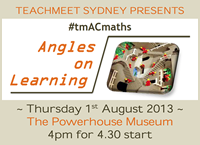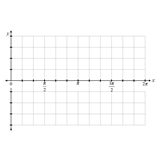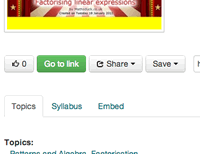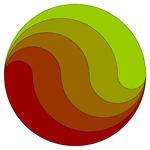Archives → MathsFaculty
Pythagorean Dates
 Monday (17/08/15) was a Pythagorean Day (172 = 82 + 152).
Monday (17/08/15) was a Pythagorean Day (172 = 82 + 152).
Magic Vs - Year 5 Lesson
 Today I had the fun of 20 Year 5 students in my classroom. I used the Magic Vs problem from NRICH. NRICH have lots of good leading questions, solution discussions and videos. There was lots of great thinking and discussion.
Today I had the fun of 20 Year 5 students in my classroom. I used the Magic Vs problem from NRICH. NRICH have lots of good leading questions, solution discussions and videos. There was lots of great thinking and discussion.
I made a SMART Notebook file to aid the discussions, available on MathsFaculty.
Relative Frequency - Investigation
Probability is one of those topics where it's best to "see it".
The transience of sharing
As a serial organiser, a brain cell explodes when I read on a social network involving teachers, "where can I find?" or "has anyone got?".
Rounding Using Significant Figures - MathsFaculty
A resource I put together for practising rounding using significant figures.
Self-checking Christmas Worksheet
Here's a self-checking, simple questions, as you get the answers correct the tree lights up.
Nothing fancy. Just needed something for a computer lab tomorrow.
Constructing Triangles
One of the challenges I had this week when students were constructing rectangles and squares using a ruler and set square (drafting triangle) was checking the accuracy of the measurements (sides and angles). I walked around with a ruler and set square checking their drawings.
Square Design
I found this design on a photocopied worksheet from an old textbook, but I don't know which, so cannot credit.
(If you know the source, please let me know)
Water usage and collection
For my HSC Mathematics General 1 class, we are currently completing the Focus Study FSPe1CEC Water usage and collection.
In this topic, students interpret information, make comparisons, and perform a range of calculations in relation to personal water usage.
Solving Equations Booklet
These are resources I developed for a Year 9 5.1* class.
(What is not shown in these resources is not all of the conceptual steps I took with this class.)
MathsLinks This Week 11 May 2014
I want to start writing more regularly to highlight some of the resources on MathsLinks and MathsFaculty, and putting them in the context of my teaching.
Activity - Atlantis and Hubble in front of the Sun
If we can determine the altitude of a plane in front of the moon, why not try the altitude of the Space Shuttle Atlantis in front of the Sun?
Activity- Airplane in front of the moon
Back in 2011, Nordin Zuber posted this found image on MathsLinks.
MathsClass This Week 21 September 2013
The September/October holidays edition...
Last week was the annual MANSW conference, and I posted a couple of summaries.
Classifying Data - Foldable
Here’s a second foldable for the Preliminary (Year 11) General Mathematics course for the topic DS1 Statistics and society, data collection and sampling.
This second foldable is about classifying data.
Statistical Inquiry Foldable
I’m trying to make the time to create foldables to use with my Year 11 General Mathematics class. The topic DS1 Statistics and society, data collection and sampling lends itself to foldables.
The first foldable is for the process of statistical inquiry:
posing questions, collecting data, organising data, summarising and displaying data, analysing data and drawing conclusions, and writing a report
MathsClass This Week 3 August 2013
TeachMeet AC Maths on Thursday gone was fantastic. Check out the wiki page for the presentations.
Here’s my 2 minute presentation about MathsLinks.
Lots of links added to MathsLinks and and files added to MathsFaculty.
MathsClass This Week 28 July 2013
 For teachers in Sydney, I hope to see you at the TeachMeet for the Australian Curriculum in Maths – this week, Thursday 1st August 2013.
For teachers in Sydney, I hope to see you at the TeachMeet for the Australian Curriculum in Maths – this week, Thursday 1st August 2013.
MathsClass This Week 6 July 2013
A reminder about the new feature added this week. You can now leave a comment on any link or resources shared on MathsLinks and MathsFaculty.
The comment might be a teaching idea or a review of the resource.
Sharing those ideas
In January, I wrote “let’s make 2013 the Year of Sharing”. We probably all know that some of the best sharing is not a specific link or a tangible resource, but an idea. Those discussions may happen in the staffroom, over a coffee, on playground duty or on a social network.
MathsClass This Week 29 June 2013
 Sydney, Australia, based teachers put Thursday 1st August 2013 in your diary for the TeachMeet Australian Curriculum Maths.
Sydney, Australia, based teachers put Thursday 1st August 2013 in your diary for the TeachMeet Australian Curriculum Maths.
MathsClass This Week 8 June 2013
This week, MathsLinks hit 700 links all categorised by topics and syllabus.
MathsClass This Week 1 June 2013
 Lots of additions to the Downloadable Essentials section on MathsKit this week. Including: A page of table of values and coordinate grids, pages of number lines, some more pie charts and trigonometric graphs, blank, degrees and radians.
Lots of additions to the Downloadable Essentials section on MathsKit this week. Including: A page of table of values and coordinate grids, pages of number lines, some more pie charts and trigonometric graphs, blank, degrees and radians.
Number Sense Posters
For a few years, I’ve noticed that kids not only don’t know/struggle with their times tables, but also general ‘number sense’.
Animated Budgie
Mathematical Induction, topic 7.4 in the NSW Board of Studies Mathematics Extension 1 Syllabus, is difficult conceptual. I suspect students think there is a bit of smoke and mirrors happening. One introduction that I use, I first saw in a resource by Stuart Palmer. The same story appears in this article online: Mathematical Induction (PDF 92KB), Helen Bush, Reflections August 1992 sourced on NSW HSC Online.
MathsClass This Week 9 March 2013
For users of Pinterest, you can now share links on MathsLinks to Pinterest. Click the Share dropdown.
Try it on this link, you get a nice screenshot of the site in Pinterest.
MathsClass This Week 2 March 2013
Try out the Word Search on MathsStarters. There are only three versions at the moment (although the placement of the letters is different each time you play the game). If you’d like to add a game, just send me a comma-separated list of words and a title for you game. For teachers in NSW, Australia, my current aim is to make a word search for each topic in the NSW General Mathematics syllabus.
Also, I’ve added the search functionality back on this blog.
MathsClass This Week 23 February 2013
Today, MathsStarters Quick Quiz got an update with several additional quizzes. Bingo got a new game, ‘Writing Rates’.
It’s time to share
Now that we have a National Curriculum in Australia, let’s make 2013 the Year of Sharing.
MathsClass This Week 30 December 2012
If you haven’t visited the site recently, there is a new look across MathsLinks, MathsFaculty, MathsKit and MathsClass.
The redesign is still a work in progress, and the main aim is to make it easier to use MathsLinks and MathsFaculty.
MathsClass This Week 23 December 2012
Some seasonal links this week, enjoy the break. Merry Christmas.
Keep an eye out for new look sites soon.
Consumer Arithmetic - Spending - Electronic Worksheets
This is part 2 of my electronic worksheets for Consumer Arithmetic. Part 2 focuses on Spending Money, in particular: profit and loss, discounts, purchasing, best buys and buying on terms (hire purchase). (Part 1 focused on earning money)
MathsClass This Week 2 December 2012
 Nearing the end of the year, I’ve updated a previous MathsClass blog post from 2008 with additional supporting material to make this nice design. Files available on MathsFaculty.
Nearing the end of the year, I’ve updated a previous MathsClass blog post from 2008 with additional supporting material to make this nice design. Files available on MathsFaculty.
There are other end of term activities on MathsClass and design activities on MathsFaculty.
MathsClass This Week 20 October 2012
Since May, I have been posting a weekly summary of the links and resources added to my other sites, MathsLinks and MathsFaculty, calling it “MathsClass This Week”. A quick poll: (viewing via an RSS feed or email, you probably need to visit the site to complete the poll)
MathsClass This Week 23 September 2012
A lot of links and files this week…
MathsClass This Week 16 September 2012
Did you go to the 2012 MANSW Conference? If you don’t have a blog, consider leaving your reflections as a comment here.
MathsClass This Week 2 September 2012
This looks interesting… the GeoGebra for the iPad project is looking for funding on Kickstarter. Currently only 25% funded.
Thanks for the comments on last week’s post Being too helpful?.
MathsClass This Week 26 August 2012
First up, here on MathsClass, I’ve raised a question about being too helpful. Do you have any comments? Nordin’s comment is a good read.
Rules for Differentiation - Foldable (Math4Math)
A foldable for reviewing the Rules of Differentiation. Click the preview to see the full version.
Functions and Quadratics Foldables (Made4Math #1)
Year 11 Mathematics have one of their three periods a week, last period on Fridays. Of course, they’re not highly motivated at that time.
The other week, we folded parabolas, I called it “Arts and Craft Friday”.
The next week, they surprised me by asking what we were doing for “Arts and Craft Friday”... I had nothing!
Connecting MathsLinks and MathsFaculty
I suspect that as you find great resources on the net, many time, like me, you still have a need to scaffold an activity around that resource… maybe resulting in the creation of supplementary material.
MathsClass This Week 1 Jul 2012
Most teachers have a USB stick full of their teaching resources… similarly most schools have a file server with a Mathematics folder chocked full of stuff that has been randomly downloaded, scanned or created.
But, what about web-sites? I’ve seen many Word docs named “websites.doc” and shake my head. At a professional development course I went to, the presenter had addresses for web-sites he used in a text file, I suggested he use MathsLinks, but his reasoning was sound – he had the links with him with other resources for a lesson. Social bookmarking sites like Pinboard (my recommendation, here are my maths bookmarks) are great, but I found categorising on MathsLinks suited me even better, then I made it public.
Now I’m adding some features to MathsLinks which are a little bit old-school, but will hopefully make it more useful when programming and sharing links with colleagues:

Save link to your computer – this will download a “url” file to your computer, a shortcut to the web-site. Double click it on your machine and you will be taken to the site. (Mac users, it will open Safari, no option)
Print to PDF – downloads a PDF with the essentials about the web-site with links to the site on MathsLinks as well as direct to the site.
Try it on these links…
MathsClass This Week #5
MathsStarters
Yesterday, I announced that I added a Maths Bingo game to MathsStarters. Since then, I’ve added Expansion (algebraic) and Unit conversion games.
Elsewhere…
MathsClass This Week #2
 Nothing to do with MathsClass, this week saw the addition of Emma to our family.
Nothing to do with MathsClass, this week saw the addition of Emma to our family.
Four maths teachers kindly shared their work on MathsFaculty for others to use.
MathsClass This Week* #1
Recently my online focus has shifted to my network of sites. This network is about making the essentials for maths teaching easier to find and more accessible.
MathsKit is a page of all those everyday resources.
MathsLinks now has over 500 online activites for maths, all categorised.
My new site, MathsFaculty is for maths teachers to share. I suspect that everyday, teachers waste time searching for, and if they don’t find, creating resources. Let’s fix that by sharing.
Each week, I’m going to use this blog to summarise what has been added across these sites.
* “This Week” is more like “recently” for this first review.
New Subscribe to the …
MathsLinksemail newsletter
Get updates…
About
Simon Job — eleventh year of teaching maths in a public high school in Western Sydney, Australia.
MathsClass is about teaching and learning in a maths classroom. more→
Archive
Elsewhere
 @simonjob
@simonjob
updates via  @mathslinks
@mathslinks
Recently read/found.
Being a Vector is not Mutually Exclusive – Ringo Mok
maths vectorsInstagram
Gcf howie_hua maths